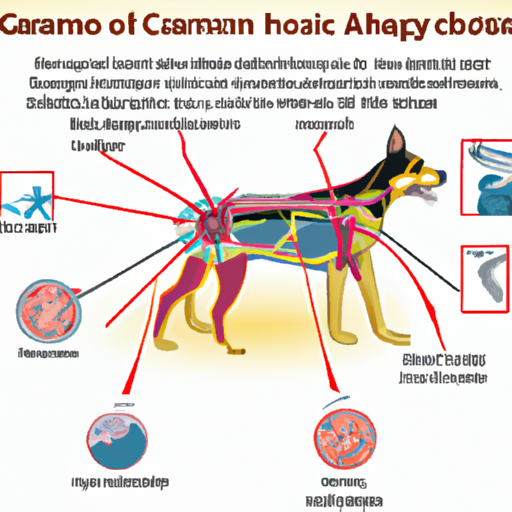“`markdown
What Causes Hemangiosarcoma in Dogs?
Understanding Hemangiosarcoma
You might never have heard of hemangiosarcoma until your beloved pet is diagnosed with it. Hemangiosarcoma is a malignant tumor of the blood vessels that commonly occurs in dogs. It’s a sneaky and insidious disease that often doesn’t show symptoms until it’s in advanced stages.
The Root Cause of Hemangiosarcoma
The exact cause of hemangiosarcoma in dogs is still unknown. However, researchers believe that there could be a genetic predisposition. Certain breeds like Golden Retrievers, German Shepherds, and Labrador Retrievers are more prone to this disease.
Nevertheless, it’s important to remember these factors:
- Age: Hemangiosarcoma is commonly seen in middle-aged to older dogs.
- Gender: Male dogs are more likely to develop this disease than females.
- Size: Large breed dogs are more susceptible to hemangiosarcoma.
Recognizing the Symptoms
Symptoms of hemangiosarcoma can be subtle and easily missed, making this disease even more dangerous. Here are some signs to watch out for:
- Unexplained weight loss
- Difficulty breathing
- Lethargy
- Pale gums
- Distended abdomen
Remember, early detection is the key to effective management and treatment.
Treatment Options
Treatment options for hemangiosarcoma vary based on the stage and location of the tumor. The most common treatments include:
- Surgery: This is typically the first line of defense if the tumor is localized.
- Chemotherapy: It’s often used in combination with surgery, especially for tumors that have spread.
- Radiation Therapy: This can be used in certain cases where surgery is not an option.
| Treatment Option | Description |
|---|---|
| Surgery | Removal of tumor |
| Chemotherapy | Medication to kill cancer cells |
| Radiation Therapy | High-energy rays to kill cancer cells |
Preventive Measures
While there’s no surefire way to prevent hemangiosarcoma, certain measures can help reduce the risk:
- Regular Vet Check-ups: Regular examinations can help detect any abnormalities early.
- Healthy Diet: A balanced diet can boost your dog’s immune system.
- Regular Exercise: This helps maintain overall health and wellbeing.
Frequently Asked Questions
Q: Can hemangiosarcoma be cured?
A: Unfortunately, hemangiosarcoma is usually aggressive and has a poor prognosis. However, early detection and aggressive treatment can improve survival times.
Q: Is hemangiosarcoma painful for dogs?
A: Yes, hemangiosarcoma can cause discomfort and pain, especially in advanced stages.
Q: What’s the life expectancy of a dog diagnosed with hemangiosarcoma?
A: The prognosis varies depending on the stage and location of the tumor. With treatment, some dogs may live for a few months to a year.
Q: Can a young dog get hemangiosarcoma?
A: While it’s more common in older dogs, young dogs can also develop hemangiosarcoma.
“`



